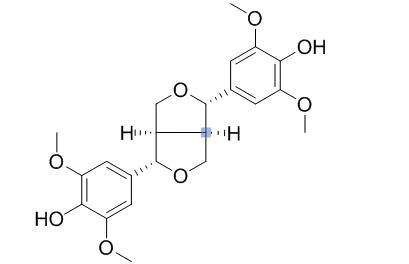| In vitro: |
| Biol Pharm Bull. 2006 Jan;29(1):172-3. | | Inhibition of Helicobacter pylori motility by (+)-Syringaresinol from unripe Japanese apricot.[Pubmed: 16394533] |
METHODS AND RESULTS:
A methanol extract from unripe Japanese apricot showed inhibitory activity of Helicobacter pylori motility.
CONCLUSIONS:
Inhibitory compound 1 was isolated and identified as (+)-Syringaresinol (1) by spectoroscopic means. (+)-Syringaresinol (1) inhibited >90% of the H. pylori motility at a concentration of 500 microg/ml and the IC50 value was 50 microg/ml. | | J Agric Food Chem. 2008 Sep 10;56(17):7759-64 | | Lignans and other constituents of the fruits of Euterpe oleracea (Acai) with antioxidant and cytoprotective activities.[Pubmed: 18656934 ] |
METHODS AND RESULTS:
Using a hydroxyl radical scavenging assay, bioactivity-guided fractionation of a methanol-soluble extract of the fruits of Euterpe oleracea (acai) led to the isolation of 22 compounds of previously known structure.
CONCLUSIONS:
Altogether, 14 of these isolates were found to be active in an in vitro hydroxyl radical scavenging assay and seven of these isolates in a 1,1-diphenyl-2-picrylhydrazyl radical scavenging assay. Dihydroconiferyl alcohol, (+)-lariciresinol, (+)-pinoresinol, (+)-Syringaresinol, and protocatechuic acid methyl ester exhibited cytoprotective activity in cultured MCF-7 cells stressed by H2O2.
Lignans have not been previously reported as constituents of this species and were found to be representative of the aryltetrahydronaphthalene, dihydrobenzofuran, furofuran, 8-O-4'-neolignan, and tetrahydrofuran structural types. | | J Agric Food Chem. 2011 Feb 23;59(4):1199-204 | | Isolation and identification of compounds responsible for antioxidant capacity of Euryale ferox seeds.[Pubmed: 21280632] | Euryale ferox seed is consumed medicinally or for food in China.
METHODS AND RESULTS:
The present study revealed it to contain significant antioxidant activity, which may be associated with its medical applications as a proteinuria inhibitor of diabetic nephropathy.
This study resulted in the identification of 3 new sesquineolignans, named euryalins A-C (1-3), and 16 known compounds, which were all first isolated from this plant apart from 5,7,4-trihydroxy-flavanone. The antioxidant potential of the partial isolates was evaluated using the DPPH radical scavenging assay and mesangial cellular assay. Compounds 2, rel-(2α,3β)-7-O-methylcedrusin (4), syringylglycerol-8-O-4-(sinapyl alcohol) ether (5), and (+)-Syringaresinol (7) were found to be most active on DPPH assay, whereas compounds 2, 4, 7, (1R,2R,5R,6S)-2-(3,4-dimethoxyphenyl)-6-(3,4-dihydroxyphenyl)-3,7-dioxabicyclo[3.3.0]octane, and buddlenol E could significantly inhibit high glucose-stimulated reactive oxygen species production in mesangial cells.
CONCLUSIONS:
The results suggested that E. ferox seed could be considered as an excellent source of natural antioxidants and is useful in the prevention of diabetic nephropathy. |
|






 Cell. 2018 Jan 11;172(1-2):249-261.e12. doi: 10.1016/j.cell.2017.12.019.IF=36.216(2019)
Cell. 2018 Jan 11;172(1-2):249-261.e12. doi: 10.1016/j.cell.2017.12.019.IF=36.216(2019) Cell Metab. 2020 Mar 3;31(3):534-548.e5. doi: 10.1016/j.cmet.2020.01.002.IF=22.415(2019)
Cell Metab. 2020 Mar 3;31(3):534-548.e5. doi: 10.1016/j.cmet.2020.01.002.IF=22.415(2019) Mol Cell. 2017 Nov 16;68(4):673-685.e6. doi: 10.1016/j.molcel.2017.10.022.IF=14.548(2019)
Mol Cell. 2017 Nov 16;68(4):673-685.e6. doi: 10.1016/j.molcel.2017.10.022.IF=14.548(2019)